|
Monday, January 31, 2011
Progress Notes
In the Progress Notes of December 27 I told the story of Champ Smith, son of the Revolutionary War veteran, Charles Smith. Champ was one of early Miller County’s most progressive and civic minded individuals (photo 01).
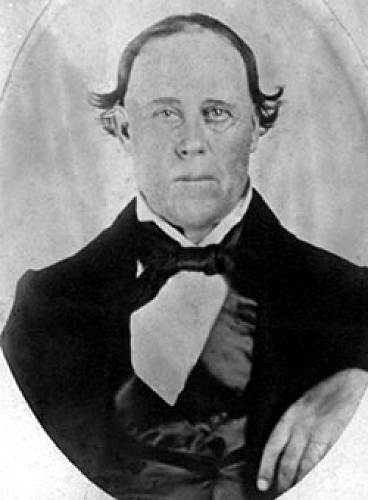
01 Champ Smith Champ was married to Martha W. Sellars (photo 02).
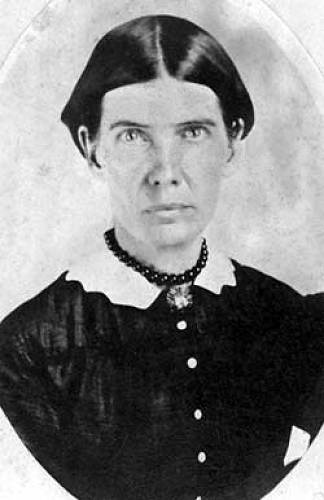
02 Martha Sellars Smith - Wife of Champ Smith Their daughter, Lavicia Ann, married Joseph Bennett Challes in 1851 (photo 03).
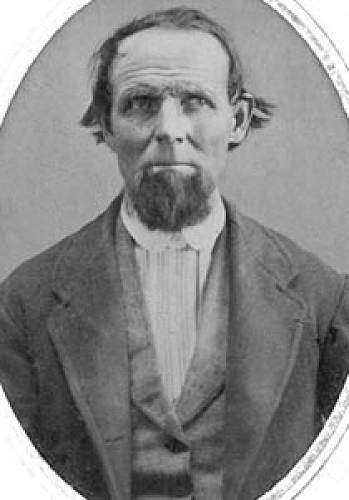
03 Joseph Bennett Challes 1821-1876 Their daughter, Martha V. Challes (photo 04), married William Henry Hauenstein, II (photo 05).
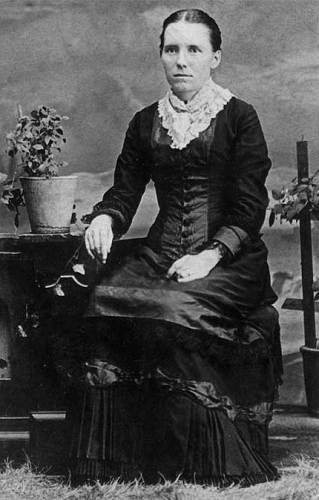
04 Martha V. Challes
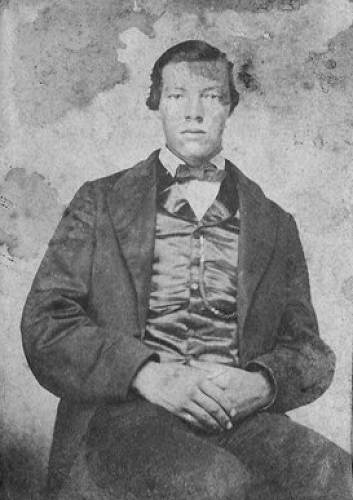
05 Captain William H. Hauenstein, II This was William’s second marriage as his first wife, Sarah Elizabeth Goodrich, drowned early in their marriage. Martha Challes’ father, Joseph Bennett Challes, was the son of Hugh Challes, an early Miller County settler, about whom I will have more to write later.
The interesting thing about this particular genealogical line is that it illustrates how quite a few long time Miller County residents alive today can trace their roots back to our earliest forefathers. In this case, I am thinking of our great friend, Bamber Wright, born and raised in Tuscumbia and one of our most valued resources for Tuscumbia history (photo 06).
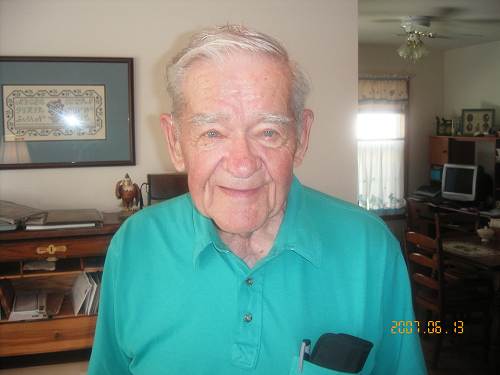
06 Bamber Wright You see, if you work it back you find that Champ Smith was Bamber’s great great grandfather, and that Champ’s father, Charles Smith, the Revolutionary War veteran, was Bamber’s great great great grandfather. This works out because Bamber’s mother, Elizabeth Hauenstein Wright (photo 07), was the daughter of William Hauenstein II (or Jr.) and his wife Martha Challes who was the granddaughter of Champ Smith.
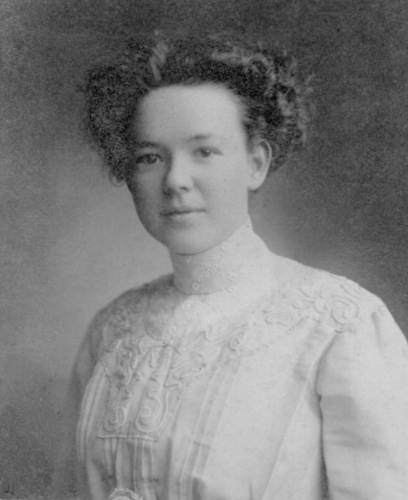
07 Elizabeth Hauenstein Continuing back through the Challes line one finds that Hugh Challes was Bamber’s great great grandfather since Joseph Bennett Challes was the son of Hugh Challes.
Hugh Challes (son of John Challes and Milly Rice) was born 18 Dec 1787 in Rockingham County, North Carolina, and died 6 Feb 1872 in Miller County, Missouri. He married Mary Bennett on 16 Feb 1817 in Madison Co. Kentucky. She was the daughter of Joseph and Margaret Bennett. The Challes’ came from France about the time of the Revolutionary War and settled in Rockingham County, North Carolina, later moving to Madison County, Kentucky. Hugh and Mary came to Boone Co. Missouri about 1820 and moved to Miller County about 1834.
According to several Challes entries in Jenkins’ History of Miller County the following items are mentioned regarding Hugh Challes:
1834 Hugh Challes patented land
1837 July 1: first election in county. Hugh Challes one of three judges
1841 Miller County’s first financial statement. Hugh Challes owed $36.24 to county for road and canal fund.
1848 appointed commissioner of school district No. 10 located in T40N R15W near mouth of Little Gravois
1849 appointed Miller County Public Administrator
Hugh bought farm land in the flatwoods area of Equality Township just a few miles north west of Tuscumbia. His property was located in T40N R15 Sections 12 and 13. Here are two 1905 township maps locating his property, first the overall Township map (photo 08) and then a closeup of sections 11, 12, 13 and 14 (photo 09).
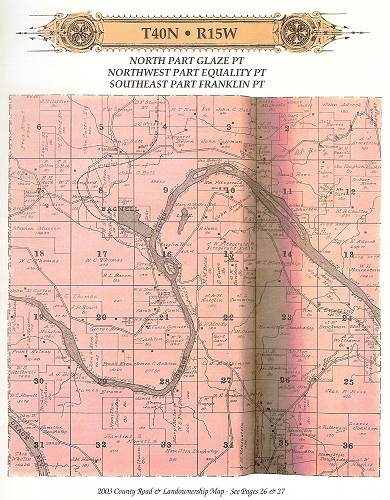
08 T40N - R15W
Click image for larger view
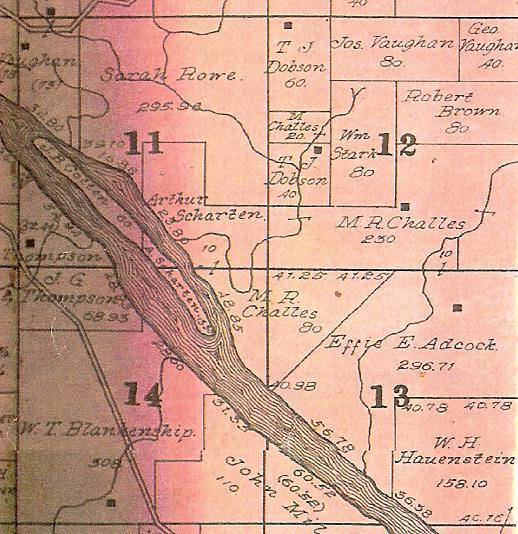
09 Sections 11, 12, 13 and 14 You will notice that the Challes land in the Township maps is located in sections 12 and 13. The property is identified as being owned by M. R. Challes, who was a son of Hugh Challes. Section 13 is where the Challes Family Cemetery is located.
A short biography of Hugh Challes is copied here:
Central Counties of Missouri History
Pioneer Settlement Miller County, page 5
Hugh and Mary (Bennett) Challes were early pioneers of Boone County, Missouri. They came south to what is today Miller County, but when they settled there in 1834, it was still part of Cole County. Hugh was a native of South Carolina and Mary (Bennett) was born in Kentucky. Hugh and Mary’s children were: Sidney (1820-1856); Joseph (1821-1876) who married Louisa Ann Smith in 1851; Amanda (1824-?), who married Daniel Cummings in 1843; Malinda (1828-1861); Emily (1831-1920) who married James Johnston in 1851, the son of John and Nancy (Berry) Johnston of Virginia and Kentucky respectively; William R. (1837-1861); and Milton R. (1839-?) who never married. Sidney died in 1856 shortly after becoming a young attorney in Miller County. He had just entered the bar but did not live long enough to practice his new profession.
Peggy Hake wrote the following information which is taken from her biography of one of Hugh and Mary’s children, Emily Challes:
“Hugh and Mary (Bennett) Challes, with 3 of their children, are buried on their homesteaded land near the Osage River, just off the Hall Store Road west of Tuscumbia.”
Note: As identified above in the 1905 plat maps.
“The old cemetery has been inventoried as Challes Family Cemetery. Their son Sidney Challes, died in 1856 shortly after becoming a young attorney in Miller County. He had just entered the bar but did not live long enough to practice his new profession. I found no record of a marriage for him or a place of burial, but would speculate he is also buried in the family cemetery on the old Challes farm place.”
Nancy Thompson has researched and put together a detailed genealogical tabulation of the Challes family in two different formats where much more information is available. I will place these genealogies here as two different attachments (photos 10 and 11).
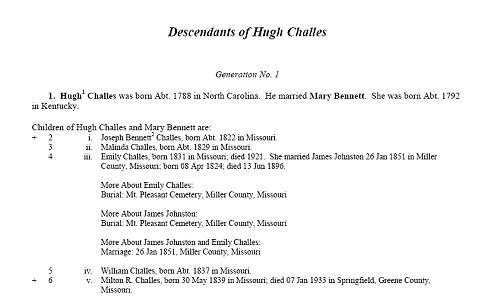
10 Hugh Challes Genealogy 1
Click image to view entire document in PDF format
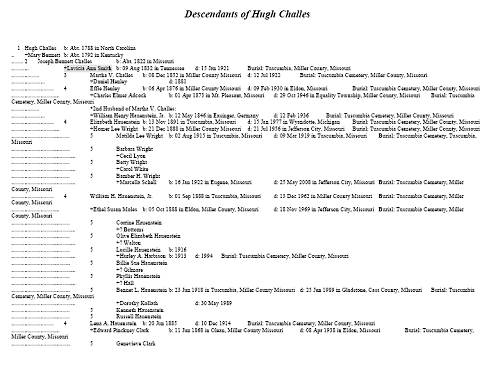
11 Hugh Challes Genealogy 2
Click image to view entire document in PDF formatThe surname Challes no longer is prominent in Miller County nor perhaps even remembered by most residents. However, it is important to recognize the importance of the family’s contribution to early Miller County history as well as its relationship with other important Miller County families of that era.
In the Progress Notes of December 20 last year I wrote about an Indian burial site known as a Cairn which is located on the J.R. Wells farm near Tuscumbia. I had requested the expert opinion of Ellis Bray to confirm for me that I was correct in identifying the area as an Indian burial. Originally, the site had been pointed out to me by Roy Sone, grandson of J.R. Wells. Here is a photo of the site as well as Ellis and his wife, Jackie (photos 12 and 13).
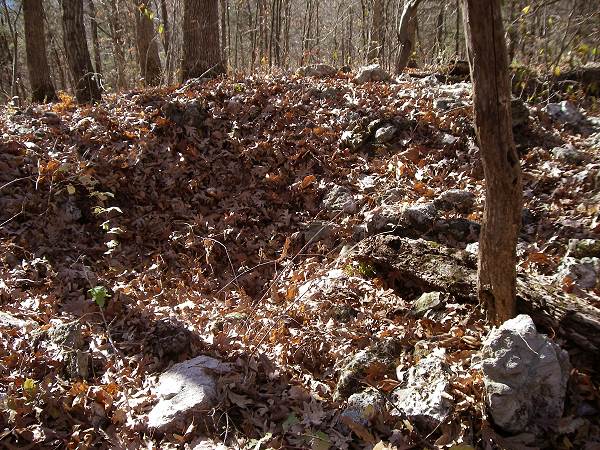
12 Cairn on Wells Farm
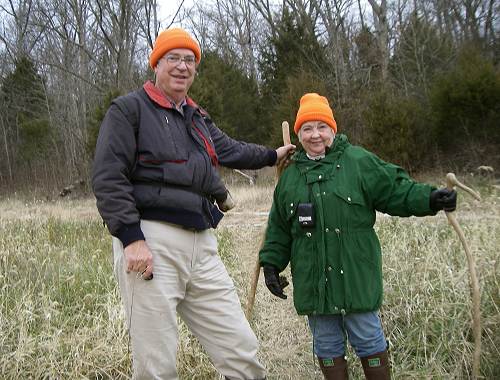
13 Ellis and Jackie Bray I found an old article about Osage Indian burials in the book, History of Missouri written by Howard Louis Conard which I am going to copy here. I have been referring to this old book for various topics recently because in some instances I think more accurate information is obtained when the source was alive long enough ago to have talked with witnesses of the event being considered. In this article Howard describes a typical burial site which has features quite similar to the old Cairn described above located on the Wells farm. In addition, Howard gives a fascinating account of other Osage Indian burial traditions and rites which I think are of great interest.
Indian Burials
From History of Missouri
by Howard Louis Conard
The burial customs of the Osage Indians are better known than those of other Western tribes. When death had occurred the corpse was wrapped in a blanket, taken to a mound or other conspicuous spot, and covered with earth and stones. The grave was then fenced in with crossed stakes to protect it from wolves. It was customary to sacrifice at the tomb all the horses belonging to the deceased, and to there destroy his hunting implements and other property, in the belief that these immolations would supply his wants during his journey to his new hunting ground. In some instances the corpse was conveyed to the grave upon his favorite horse, which was then killed and interred with him. Only the nearest relatives attended the funeral. The male mourners wore their most shabby garments, covered their faces with dirt and allowed their hair to grow. The women also dressed in their poorest clothing, but clipped their hair closely. They displayed these evidences of mourning until some offering had been made to the spirit of the deceased, and often weeks or months elapsed before this was accomplished. The offering, which differed according to the character and achievements of him who was commemorated, might be the stealing of a horse, burning the lodge of an enemy, the performance of a valorous deed, the sacrifice of a favorite animal, or the taking of a human life. The latter act was of frequent occurrence, and at times the victim was a near relative or close friend. The wife retained her mourning for a year, and its laying aside was observed with a final ceremony in honor of the deceased. At this time those whose lamentations were the loudest were esteemed as paying the sincerest tributes to the dead, and were recompensed by the family. The death of a female was regarded more lightly, but there were instances where young braves or young white men were slain in order that the deceased might have a spirit companion on her journey from earth.
The subject of Indian Burials leads naturally to another interesting and ancient figure, the Indian Medicine Man. Once again, I am copying an article about the Medicine Man from Howard Louis Conard:
Indian Medicine Men
History of Missouri
By Howard Louis Conard
Few diseases were known among the Indians prior to the coming of the white man. For ordinary ailments they treated themselves with simple remedies. The Osages used certain roots for the cure of snake bites, but the remedy failed as often as it succeeded. In some diseases vapor baths were used, taken in temporary lodges put up for that purpose. In local affections attended with pain, dry and wet cups were applied, the cups being made of buffalo horn. The Medicine Man was only called in serious cases, and while in discharge of these duties he was treated with the highest honor.
An example of his treatment is given in the case of a little girl, the daughter of a chief, who was threatened with the loss of an arm from injury by a blow. The wound had occasioned an abundant secretion of pus and the child had suffered intensely for many days. The Medicine Man was sent for and came grotesquely dressed, with his face and arms painted red and green.
He was received with great deference, and all the family withdrew, leaving a white trader as the only spectator of what followed. The Medicine Man began with a solemn exorcism. With hands uplifted he called upon the evil spirit to leave the child. He then lay down at her side, and putting his lips and teeth to the most painful spot, he pulled the skin violently from one side to the other, meantime keeping up a peculiar nasal noise, and at times uttering threatening exclamations against the cause of the hurt. After thus continuing for about fifteen minutes his exclamation became more excited and he pulled the girl’s flesh more violently with his teeth, then sprang to his feet and spat from his mouth a small frog which he had brought with him and had kept concealed. Pointing to the frog, the Medicine Man exultingly cried that the girl had been relived of the cause of her agony. He then threw upon the fire a quantity of aromatic root, and with this the smoke was supposed to ascend the remaining causes of the sufferer’s illness. A similar ceremony was observed by the Medicine Man in nearly all cases of sickness or injury, the evil spirit being a frog, a grasshopper, a pebble or whatever object he might think to use.
I have written about the early native inhabitants of Miller County previously in previous Progress Notes. For review of those essays refer to the article written by Peggy Hake in the January 19, 2009 Progress Notes.
Also, a shorter article by Irene Fitzgerald is located in the Progress Notes of November 16, 2009.
But for this week, I want to copy a short summary of the Indians of Missouri written by a man named G.C. Broadhead as found in Conard’s History of Missouri:
Indians in Missouri
G.C. Broadhead
History of Missouri
Edited by Howard Louis Conard
At different times Missouri was inhabited by the Osages, Missouris, Iowas, Sacs and Foxes, Kickapoos, Shawnees and Delawares.
In the early part of the eighteenth century the Osages had possession of all of southwest Missouri, and were, no doubt, the most powerful tribe in Missouri, and their parties would go on expeditions as far as the lakes.
Billon’s “Annals of St. Louis” informs us that there were estimated in 1810 to be about 20,000 Indians in Missouri, including Sacs, Foxes, Shawnees, Delawares, Osages and Iowas. The Osages occupied Bates and Vernon counties until 1824, and continued to hunt in Henry County until 1837. They had a village seven miles northeast of Nevada and one three miles north of Balltown. In 1808 by treaty they relinquished their right to all territory east of a line running due south to the Arkansas River from a point two miles east of Fort Osage (now Sibley). In 1824 they relinquished their right to the strip lying wet to the State line. Up to 1835 the Shawnees and Osages had villages in Benton County and lived peaceably with the white people. In 1794 there were two Shawnee and one Delaware village on Apple Creek, Cape Girardeau County, twenty miles from its mouth, and in 1811 one of their towns had eighty houses. The Shawnees also resided on the Meramec during the early part of the nineteenth century. Until 1824 there were 3000 Indians in Perry County, two thirds of them Shawnees, the other one third Delawares.
In 1823 the Delawares built a town in Christian County; they also lived in Stone County. In 1830 they were removed to Kansas. They returned to hunt every year until 1836, but annoyed the people so much that the Governor sent a militia force to investigate and after that the Indians gave no more trouble. At one time the Osages, then the Delawares and Kickapoos, lived in Greene County. In 1840 the Delawares ceded their lands to the United States. The Sacs and Foxes lived in Carroll County until 1820.
In 1814 the Miamis had villages on the Petite Osage Plains, Saline County, and were troublesome to the settlers in Howard County. General Dodge marched to their village and took about 400 of them, men, women and children, and sent them to their nation on the Wabash, in Indiana.
The Osage Indians were not the earliest inhabitants of Missouri or Miller County. Gerard Schultz has written a short couple of paragraphs about these prehistoric inhabitants of Miller County:
History of Miller County
The Ozark Bluff Dwellers p. 17
Gerard Schultz
Centuries before the coming of the white men modern Miller County belonged to a people known as the Osage Bluff Dwellers.
These people were followed by another prehistoric race. After that came the Osage Indians, the first historical inhabitants.
The Ozark Bluff Dwellers did not know the bow and arrow, but used the atlatl as a weapon.
They practiced agriculture and cultivated corn, beans, pumpkins, summer and winter squashes, egg gourds, sunflowers and other plants. In cultivating their ground they used hoes made of stone and mussel shells fastened to wooden handles. Their favorite meats were venison, turkey, bear, elk and buffalo. They also ate the meat of many smaller animals. An interesting fact about these people is that they did not know tobacco. Dr. Melvin B. Gilmore of the University of Michigan writes:
“After careful search and examination of all vegetable material found as left in the rock shelter habitations, I have not found a single trace of any tobacco plant, neither seeds, stems, nor leaves. In this connection it should also be said that not a pipe was found among all the artifacts of the Bluff Dwellers.”
Most people know how the indigent original inhabitants of our country were given the name “Indian” even though this country is a long distance from the country of India. However, Howard Louis Conard gives a brief discussion of that question which I will copy here:
Indians: Why So Called?
History of Missouri
Howard Louis Conard
When Columbus landed on the Island of San Salvador he supposed that he was landing on an island at the extremity of India, and hence he called the inhabitants of the island “Indians.” By that name he continued to call the natives of America, and Spanish writers from the outset gave them the same name. The English translators of these writers followed in their footsteps, and while the name applied originally only to the tribes with which the Spanish came into contact, by degrees it was extended to all the natives of the continent, and they have since been known as "American Indians."
That’s all for this week.
 Joe Pryor
Previous article links are in a dropdown menu at the top of all of the pages.
|

